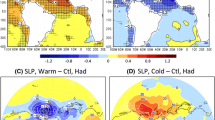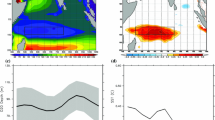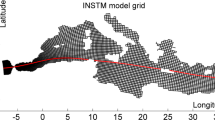Abstract
A preindustrial climate experiment was conducted with the third version of the CNRM global atmosphere–ocean–sea ice coupled model (CNRM-CM3) for the Intergovernmental Panel on Climate Change Fourth Assessment Report (IPCC AR4). This experiment is used to investigate the main physical processes involved in the variability of the North Atlantic ocean convection and the induced variability of the Atlantic meridional overturning circulation (MOC). Three ocean convection sites are simulated, in the Labrador, Irminger and Greenland–Iceland–Norwegian (GIN) Seas in agreement with observations. A mechanism linking the variability of the Arctic sea ice cover and convection in the GIN Seas is highlighted. Contrary to previous suggested mechanisms, in CNRM-CM3 the latter is not modulated by the variability of freshwater export through Fram Strait. Instead, the variability of convection is mainly driven by the variability of the sea ice edge position in the Greenland Sea. In this area, the surface freshwater balance is dominated by the freshwater input due to the melting of sea ice. The ice edge position is modulated either by northwestward geostrophic current anomalies or by an intensification of northerly winds. In the model, stronger than average northerly winds force simultaneous intense convective events in the Irminger and GIN Seas. Convection interacts with the thermohaline circulation on timescales of 5–10 years, which translates into MOC anomalies propagating southward from the convection sites.




















Similar content being viewed by others
References
Aagaard K, Carmack EC (1989) The role of sea ice and other fresh water in the Arctic circulation. J Geosphys Res 94:14485–14498
Bacon S, Gould WJ, Jia Y (2003) Open-ocean convection in the Irminger Sea. Geophys Res Lett 30:1246. doi:10.1029/2002GL016271
Bentsen M, Drange H, Furevik T, Zhou T (2004) Simulated variability of the Atlantic meridional overturning circulation. Clim Dyn 22:701–720
Bjerknes J (1964) Atlantic air–sea interaction. Advances in geophysics, vol 10. Academic, New York, pp 1–82
Blanke B, Delecluse P (1993) Variability of the tropical Atlantic Ocean simulated with a general circulation model with two different mixed layer physics. J Phys Oceanogr 23:1363–1388
Broecker WS (1987) The biggest chill. Nat Hist Mag 96:74–82
Broecker WS (1991) The great ocean conveyor. Oceanography 4:78–89
Chapelon N, Douville H, Kosuth P, Oki T (2002) Off-line simulation of the Amazon water balance: a sensitivity study with implications for GSWP. Clim Dyn 19:141–154
Cariolle D, Déqué M (1986) Southern hemisphere medium-scale waves and total ozone disturbances in a spectral general circulation model. J Geophys Res 91:10825–10846
Cariolle D, Lasserre-Bigory A, Royer J-F, Geleyn J-F (1990) A general circulation model simulation of the springtime Antarctic ozone decrease and its impact on mid-latitudes. J Geophys Res Atmos 95:1883–1898
Chapman WL, Walsh JE (2007) Simulations of Arctic temperature and pressure by global coupled models. J Clim 20:609–632
Cheng W, Bleck R, Rooth C (2004) Multi-decadal thermohaline variability in an ocean–atmosphere general circulation model. Clim Dyn 22:537–590
Clark PU, Pisias NG, Stocker TF, Weaver AJ (2002) The role of the thermohaline circulation in abrupt climate change. Nature 415:863–869
Clarke RA, Gascard JC (1983) The formation of Labrador Sea water. Part I: large-scale processes. J Phys Oceanogr 13:1764–1778
Cayan DR (1992a) Latent and sensible heat flux anomalies over the northern oceans: driving the sea surface temperature. J Phys Oceanogr 22:859–881
Cayan DR (1992b) Latent and sensible heat flux anomalies over the northern oceans: the connection to monthly atmospheric circulation. J Clim 5:354–369
Curry RG, McCartney MS, Joyce TM (1998) Oceanic transport of subpolar climate signals to mid-depth subtropical waters. Nature 391:575–577
De Boyer Montégut C, Madec G, Fischer AS, Lazar A, Iudicone D (2004) Mixed layer depth over the global ocean: an examination of profile data and a profile-based climatology. J Geophys Res 109:C12003. doi:10.1029/2004JC002378
Delworth T, Greatbach R (2000) Multidecadal thermohaline circulation variability driven by atmospheric surface flux forcing. J Clim 13:1481–1495
Delworth T, Manabe S, Stouffer RJ (1997) Multidecadal climate variability in the Greenland Sea and surrounding regions: a coupled model simulation. Geophys Res Lett 24:257–260
Déqué M, Braun A, Piedelievre J-P, Marquet P, Dandin P, Guérémy J-F, Geleyn J-F, Bazile E, Piriou J-M, Yessad K, Courtierand P, Rochas P (1999) ARPEGE version 3, documentation algorithmique et mode d’emploi (in French, available from CNRM/GMGEC, Météo-France, 42 avenue G. Coriolis, 31057 Toulouse, France)
Dickson RR, Lazier JJ, Meincke J, Rhines P, Swift J (1996) Long-term coordinated changes in the convective activity of the North Atlantic. Prog Oceanogr 38:241–295
Douville H, Royer J-F, Mahfouf J-F (1995a) A new snow parametrization for the Météo-France climate model. Part I: Validation in stand-alone experiments. Clim Dyn 12:21–35
Douville H, Royer J-F, Mahfouf J-F (1995b) A new snow parametrization for the Météo-France climate model. Part II: Validation in a 3-D GCM experiments. Clim Dyn 12:37–52
Eden C, Willebrand J (2001) Mechanism of interannual to decadal variability of the North Atlantic circulation. J Clim 14:2266–2280
Dong BW, Sutton RT (2002) Adjustment of the coupled ocean-atmosphere system to a sudden change in the thermohaline circulation. Geophys Res Lett 29(15):1728. doi:10.1029/2002GL015229
Dong BW, Sutton RT (2005) Mechanism of interdecadal thermohaline circulation variability in a coupled ocean-atmosphere GCM. J Clim 18:1117–1135
Frankignoul C, Kestenare E, Mignot J. (2002) The surface heat flux feedback. part II: direct and indirect estimates in the ECHAM4/OPA8 coupled GCM. Clim Dyn 19:649–655
Ganachaud A (2003) Large-scale mass transports, water mass formation, and diffusivities estimated from World Ocean Circulation Experiment (WOCE) hydrographic data. J Geophys Res 108(C7):3213
Ganachaud A, Wunsch C (2000) Oceanic meridional overturning circulation, mixing, bottom water formation rates and heat transport. Nature 408:453–456
Ganachaud A, Wunsch C (2003) Large scale ocean and freshwater transports during the World Ocean Circulation Experiment. J Clim 16:696–705
Gibelin AL, Déqué M (2003) Anthropogenic climate change over the Mediterranean region simulated by a global variable resolution model. Clim Dyn 20:327–339
Gibson JK, Kallberg P, Uppala S, Hernandez A, Nomura A, Serrano E (1997) ERA description. ECMWF Reanalysis Project Report Series No.1. European Centre for Medium-range Weather Forecasts, Reading, 66 pp
Gordon AL (1986) Interocean exchange of thermocline water. J Geophys Res 91:5037–5046
Goosse H, Selten FM, Haarsma RJ, Opsteegh JD (2002) A mechanism of decadal variability of the sea-ice volume in the Northern Hemisphere. Clim Dyn 19:61–83
Hirschi JM, Killworth PD, Blundell JR (2007) Subannual, seasonnal and interannual variability of the North Atlantic meridional overturning circulation. J Phys Oceanogr (in press)
Holland MM, Bitz CM, Eby M, Weaver AJ (2001) The role of ice–ocean interactions in the variability of the North Atlantic thermohaline circulation. J Clim 14:656–675
Hunke EC, Dukowicz JK (1997) An elastic–viscous–plastic model for sea ice dynamics. J Phys Oceanogr 27:1849–1867
Hunke EC, Lipscomb WH (2002) CICE: the Los Alamos sea ice model, documentation and software User’s Manual. T-3 Fluid Dynamics Group, Los Alamos National Laboratory, Tech Rep LACC-98–16 v.3
Hurrell JW (1995) Decadal trends in the North Atlantic Oscillation: regional temperatures and precipitation. Science 269:676–679
Jungclaus JH, Haak H, Latif M, Mikolajewicz U (2004) Arctic-North Atlantic interactions and multidecadal variability of the meridional overturning circulation. J Clim 18:4013–4031
Knight JR, Allan RJ, Folland CK, Vellinga M, Mann ME (2005) A signature of persistent natural thermohaline circulation cycles in observed climate. Geophys Res Lett 32:L20708. doi:10.1029/2005GL024233
Köhl A (2005) Anomalies of meridional overturning mechanisms in the North Atlantic. J Phys Oceanogr 35:1455–472
Kushnir Y (1994) Interdecadal variations in North Atlantic sea surface temperature and associated atmospheric conditions. J Clim 7:141–157
Lavin AM, Bryden HL, Parrilla G (2003) Mechanisms of heat, freshwater, oxygen and nutrient transports and budgets at 24.5 N in the subtropical North Atlantic. Deep-Sea Res I 50:1099–1128
Lazier J (1980) Oceanographic conditions at Ocean Weather Ship Bravo 1964–1974. Atmos Ocean 18:227–238
Levitus S (1982) Climatological Atlas of the World Ocean, NOAA Professional Paper 13. US Dept of Commerce: National Oceanic and Atmospheric Administration
Madec G, Chartier M, Crépon M (1991a) Effect of thermohaline forcing variability on deep water formation in the Northwestern Mediterranean Sea: a high resolution three-dimensional study. Dyn Atmos Oceans 15:301–332
Madec G, Chartier M, Delecluse P, Crépon M (1991b) A-three dimensional numerical study of deep water formation in the Northwestern Mediterranean Sea. J Phys Oceanogr 21:1349–1371
Madec G, Delecluse P, Imbard M, Lévy C (1998) OPA version 8.1 Ocean General Circulation Model Reference Manual, Notes du Pôle de Modélisation, Institut Pierre-Simon Laplace, n°11, 91 pp [Available from Laboratoire d’Océanographie Dynamique et de Climatologie, Université Paris VI, Paris 75252, France.]
Mahfouf JF, Manzi A, Noilhan J, Giordani H, DéQué M (1995) The Land Surface Scheme ISBA within the Météo-France Climate Model ARPEGE. Part I. Implementation and Preliminary Results. J Climate 8:2039–2057
Manabe S, Stouffer RJ (1999) The role of the thermohaline circulation in climate. Tellus 51:91–109
Manabe S, Stouffer RJ (2000) Study of abrupt climate change by a coupled ocean–atmosphere model. Quat Sci Rev 19:285–299
Marshall J, Johnson H, Goodman J (2001) A study of the interaction of the North Atlantic Oscillation with the ocean circulation. J Clim 14:1399–1421
Masson V, Champeaux J-L, Chauvin F, Meriguet C, Lacaze R (2003) A global database of land surface parameters at 1-km resolution in meteorological and climate models. J Clim 16:1261–1282
Mauritzen C, Häkkinen S (1997) Influence of sea ice on the thermohaline circulation in the Arctic-North Atlantic ocean. Geophys Res Lett 24:3257–3260
Mauritzen C, Häkkinen S (1999) On the relationship between dense water formation and the Meridional Overturning Cell in the North Atlantic Ocean. Deep Sea Res 46:877–894
Mignot J, Frankignoul C (2005) On the variability of the Atlantic meridional overturning circulation, the NAO and the ENSO in the Bergen Climate Model. J Clim 18:2361–2375
Oki T, Sud YC (1998) Design of total runoff integrating pathways (TRIP). A global river channel network. Earth Interact 2:1–37
Oki T, Wishimyra T, Dirmeyer P (1999) Assessment of annual runoff from land surface models using Total Runoff Integrating Pathways (TRIP). J Meteorol Soc Japan 77:235–255
Paulson CA, Simpson JJ (1977) Irradiance measurements in the upper ocean. J Phys Oceanogr 7:952–956
Pickart RS, Spall MA, Ribergaard MH, Moore GWK, Milliff RF (2003) Deep convection in the Irminger Sea forced by the Greenland tip jet. Nature 424:152–156
Rahmstorf S (2002) Ocean circulation and climate during the past 120000 years. Nature 419:207–214
Rudels B, Quadfasel D, Friedrich H, Houssais M (1989) Greenland Sea convection in the winter of 1987–1988. J Geophys Res 94:3223–3227
Salas-Mélia D (2002) A global coupled sea ice-ocean model. Ocean Model 4:137–172
Salas-Mélia D, Chauvin F, Déqué M, Douville H, Gueremy JF, Marquet P, Planton S, Royer JF, Tyteca S (2005) Description and validation of the CNRM-CM3 global coupled model, CNRM technical report 103 [Available from CNRM/GMGEC, 42 ave. G.Coriolis, 31057 Toulouse, France or http://www.cnrm.meteo.fr/scenario2004/paper_cm3.pdf]
Schmitz WS, McCartney MS (1993) On the North Atlantic Circulation. Rev Geophys 31:29–49
Schott F, Visbeck M, Fischer J (1993) Observations of vertical currents and convection in the central Greenland Sea during the winter of 1988–1989. J Geophys Res 98:14401–14422
Seager R, Battisti DS, Yin J, Gordon N, Naik N, Clement AC, Cane MA (2002) Is the Gulf Stream responsible for Europe’s mild winters? Quart J R Meteorol Soc B 128:2563–2586
Shaffrey L, Sutton R (2006) Bjerknes compensation and the decadal variability of the energy transports in a coupled climate model. J Clim 19:1167–1168
Spall M (1993) Variability of sea surface salinity in stochastically forced systems. Clim Dyn 8:151–160
Swingedouw D, Braconnot P, Marti O (2006) Sensitivity of the Atlantic Meridional Overturning Circulation to the melting from northern glaciers in climate change experiments. Geophys Res Lett 33:L07711. doi:10.1029/2006GL025765
Talley LD, Reid JL, Robbins PE (2003) Data-based meridional overturning streamfunctions for the global ocean. J Clim 19:3213–3226
Terray L, Valcke S, Piacentini A. (1998) OASIS 2.2 User’s Guide and Reference Manual, TR/CMGC/98–05 [Available from CERFACS, 42 ave. G. Coriolis, 31057 Toulouse, France.]
Thorndike AS, Rothrock DA, Maykut GA, Colony R (1975) The thickness distribution of sea ice. J Geophys Res 80:4501–4513
Timmerman A, Latif M, Voss R, Grotzner A (1998) Northern Hemispheric interdecadal variability: a coupled air–sea mode. J Clim 11:1906–1931
Trenberth KE, Caron JM (2001) Estimates of meridional atmosphere and ocean heat transports. J Clim 14:3433–3443
Vellinga M, Wood R (2002) Global climatic impacts of a collapse of the Atlantic thermohaline circulation. Clim Change 54:251–267
Vellinga M, Wu P (2004) Low-latitude fresh water influence on centennial variability of the thermohaline circulation. J Clim 17:4498–4511
Vinje T (2001) Fram Strait ice fluxes and atmospheric circulation: 1950–2000. J Clim 14:3508–3517
Von Storch JS, Müller P, Stouffer RJ, Voss R, Simon FB (2000) Variability of deep-ocean mass transport: spectral shapes and spatial scales. J Clim 13:1916–1935
Wallace JM, Gutzler DS (1981) Teleconnections in the geopotential height field during the Northern Hemisphere winter. Mon Wea Rev 109:784–812
Wu P, Gordon C (2002) Oceanic influence on North Atlantic climate variability. J Clim 15:1911–1925
Acknowledgments
This work was carried out in the framework of a PhD thesis at the Centre National de Recherches Météorologiques, Toulouse, funded by Météo-France and the Commissariat à l’Energie Atomique (CEA). The authors wish to thank Pascal Terray and Eric Maisonnave for the availability of their statistical package STATPACK and Fabrice Chauvin for his help about Hayashi spectral analyses. Marc Lucas and Clotilde Dubois are greatly acknowledged for their careful reading of the manuscript. This study was supported by the European Commission’s 6th Framework Programme (ENSEMBLES, contract GOCE-CT-2003-505539).
Author information
Authors and Affiliations
Corresponding author
Rights and permissions
About this article
Cite this article
Guemas, V., Salas-Mélia, D. Simulation of the Atlantic meridional overturning circulation in an atmosphere–ocean global coupled model. Part I: a mechanism governing the variability of ocean convection in a preindustrial experiment. Clim Dyn 31, 29–48 (2008). https://doi.org/10.1007/s00382-007-0336-8
Received:
Accepted:
Published:
Issue Date:
DOI: https://doi.org/10.1007/s00382-007-0336-8




